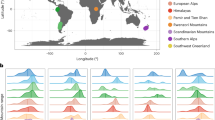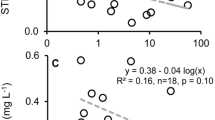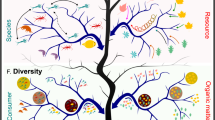Abstract
Metabolism of terrestrial organic carbon in freshwater ecosystems is responsible for a large amount of carbon dioxide outgassing to the atmosphere, in contradiction to the conventional wisdom that terrestrial organic carbon is recalcitrant and contributes little to the support of aquatic metabolism. Here, we combine recent findings from geophysics, microbial ecology and organic geochemistry to show geophysical opportunity and microbial capacity to enhance the net heterotrophy in streams, rivers and estuaries. We identify hydrological storage and retention zones that extend the residence time of organic carbon during downstream transport as geophysical opportunities for microorganisms to develop as attached biofilms or suspended aggregates, and to metabolize organic carbon for energy and growth. We consider fluvial networks as meta-ecosystems to include the acclimation of microbial communities in downstream ecosystems that enable them to exploit energy that escapes from upstream ecosystems, thereby increasing the overall energy utilization at the network level.
This is a preview of subscription content, access via your institution
Access options
Subscribe to this journal
Receive 12 print issues and online access
$259.00 per year
only $21.58 per issue
Buy this article
- Purchase on Springer Link
- Instant access to full article PDF
Prices may be subject to local taxes which are calculated during checkout

Similar content being viewed by others
Change history
20 July 2009
In the version of this of this Progress Article originally published, Table 1 was incorrect and subsequently the values of global fluvial respiration and global net heterotrophy reported in text were incorrect. These errors have been corrected in the HTML and PDF versions.
References
Cauwet, G. in Biogeochemistry of Marine Dissolved Organic Matter (eds Hansell, D. A. & Carlson, C. A.) 579–602 (Academic Press, New York, 2002).
del Giorgio, P. A. & Williams, P. J. B. Respiration in Aquatic Ecosystems (Oxford Univ. Press, USA, 2005).
Cole, J. J. et al. Plumbing the global carbon cycle: Integrating inland waters into the terrestrial carbon budget. Ecosystems 10, 172–185 (2007).
Richey, J. E. in Encyclopedia of Hydrological Sciences Vol. 5 (ed. Anderson, M. & McDonnell, J. J.) 184 (Wiley, New Jersey, 2005).
Trumbore, S. E. Potential responses of soil organic carbon to global environmental change. Proc. Natl Acad. Sci. USA 94, 8284–8291 (1997).
Cole, J. J. & Caraco, N. F. Carbon in catchments: connecting terrestrial carbon losses with aquatic metabolism. Mar. Freshwater Res. 52, 101–110 (2001).
Richey, J. E., Melack, J. M., Aufdenkampe, A. K., Ballester, V. M. & Hess, L. L. Outgassing from Amazonian rivers and wetlands as a large tropical source of atmospheric CO2 . Nature 416, 617–620 (2002).
Mayorga, E. et al. Young organic matter as a source of carbon dioxide outgassing from Amazonian rivers. Nature 436, 538–541 (2005).
Paola, C. et al. Toward a unified science of the Earth's surface: Opportunities for synthesis among hydrology, geomorphology, geochemistry, and ecology. Wat. Resour. Res. 42, doi:10.1029/2005WR004336 (2006).
Battin, T. J., Kaplan, L. A., Newbold, J. D. & Hansen, C. Contributions of microbial biofilms to ecosystem processes in stream mesocosms. Nature 426, 439–442 (2003).
Seitzinger, S. P. et al. Molecular-level chemical characterization and bioavailability of dissolved organic matter in stream water using electrospray-ionization mass spectrometry. Limnol. Oceanogr. 50, 1–12 (2005).
Frazier, S., Kaplan, L. A. & Hatcher, P. G. Molecular characterization of biodegradable dissolved organic matter using bioreactors and [12C/13C] tetramethylammonium hydroxide thermochemolysis GC-MS. Environ. Sci. Technol. 39, 1479–1491 (2005).
Kim, S., Kaplan L. A. & Hatcher, P. G. Biodegradable dissolved organic matter in a temperate and a tropical stream determined from ultra-high resolution mass spectrometry. Limnol. Oceanogr. 51, 1054–1063 (2006).
McCallister, S. L., Bauer, J. E., Cherrier, J. E. & Ducklow, H. W. Assessing sources and ages of organic matter supporting river and estuarine bacterial production: A multiple-isotope (Δ14C, δ13C, and δ15N) approach. Limnol. Oceanogr. 49, 1687–1702 (2004).
McCallister, S. L., Bauer, J. E. & Canuel, E. A. Bioreactivity of estuarine dissolved organic matter: A combined geochemical and microbiological approach. Limnol. Oceanogr. 51, 94–100 (2006).
Raymond, P. A. & Bauer, J. E. Riverine export of aged terrestrial organic matter to the North Atlantic Ocean. Nature 409, 497–500 (2001).
Leopold, L. B., Wolman, M. G. & Miller, J. P. Fluvial Processes in Geomorphology (Freeman, San Francisco, 1964).
Packman, A. I. & Bencala, K. E. in Streams and Ground Waters (eds Jones, J. A. & Mulholland, P. J.) 45–80 (Academic Press, San Diego, 2000).
Harvey, J. W. & Wagner, B. J. in Streams and Ground Waters (eds Jones, J. A. & Mulholland, P. J.) 3–43 (Academic Press, San Diego, 2000).
Wörman, A., Packman, A., Marklund, L., Harvey, J. & Stone, S. Fractal topography and subsurface water flows from fluvial bedforms to the continental shield. Geophys. Res. Lett. 34, L07402 (2007).
Bencala, K. E. in Encyclopedia of Hydrological Sciences Vol. 3 (ed. Anderson, M. & McDonnell, J. J.) 113 (Wiley, New Jersey, 2005).
Bianchi, T. S. Biogeochemistry of Estuaries (Oxford Univ. Press, New York, 2007).
Crump, B. C., Hopkinson, C. S., Sogin, M. L. & Hobbie, J. E. Microbial biogeography along an estuarine salinity gradient: Combined influences of bacterial growth and residence time. Appl. Environ. Microbiol. 70, 1494–1505 (2004).
Martin, J. B., Cable, J. E., Jaeger, J., Hartl, K. & Smith, C. G. Thermal and chemical evidence for rapid water exchange across the sediment-water interface by bioirrigation in the Indian River Lagoon, Florida. Limnol. Oceanogr. 51, 1332–1341 (2006).
Simon, M., Grossart, H. P., Schweitzer, B. & Ploug, H. Microbial ecology of organic aggregates in aquatic ecosystems. Aquat. Microb. Ecol. 28, 175–211 (2002).
Besemer, K., Moeseneder, M. M., Arrieta, J. M., Herndl, G. J. & Peduzzi, P. Complexity of bacterial communities in a river-floodplain system (Danube, Austria). Appl. Environm. Microbiol. 71, 609–620 (2005).
Besemer, K. et al. Biophysical controls on community succession in stream biofilms. Appl. Environ. Microbiol. 73, 4966–4974 (2007).
Ploug, H. Small-scale oxygen fluxes and remineralization in sinking aggregates. Limnol. Oceanogr. 46, 1624–1631 (2001).
Kiørboe, T. & Jackson, G. A. Marine snow, organic solute plumes, and optimal chemosensory behavior of bacteria. Limnol. Oceanogr. 46, 1309–1318 (2001).
Battin, T. J., Wille, A., Psenner, R. & Richter, A. Large-scale environmental controls on microbial biofilms in high-alpine streams. Biogeosciences 1, 159–171 (2004).
Hullar, M. A. J., Kaplan, L. A. & Stahl, D. A. Recurring seasonal dynamics of microbial communities in stream habitats. Appl. Environ. Microbiol. 72, 713–722 (2006).
Winter, C., Hein, T., Kavka, G., Mach, R. L. & Farnleitner, A. H. Longitudinal changes in the bacterial community composition of the Danube River: a whole-river approach. Appl. Environ. Microbiol. 73, 421–431 (2007).
Maranger, R. J., Pace, M. L., del Giorgio, P. A., Caraco, N. F. & Cole, J. J. Longitudinal spatial patterns of bacterial production and respiration in a large River-Estuary: Implications for ecosystem carbon consumption. Ecosystems 8, 318–330 (2005).
Vannote, R. J., Minshall, G. W., Cummins, K. W., Sedell, J. R. & Cushing, C. E. The river continuum concept. Can. J. Fish. Aquat. Sci. 37, 130–137 (1981).
Findlay, S. E. G. & Sinsabaugh, R. L. Large-scale variation in subsurface stream biofilms: A cross-regional comparison of metabolic function and community similarity. Microb. Ecol. 52, 491–500 (2006).
Fischer, H., Kloep, F., Wilzcek, S. & Pusch, M. T. A river's liver – microbial processes within the hyporheic zone of a large lowland river. Biogeochemistry 76, 349–371 (2005).
Oliver, R. L. & Merrick, C. J. Partitioning of river metabolism identifies phytoplankton as a major contributor in the regulated Murray River (Australia). Freshwat. Biol. 51, 1131–1148 (2006).
Junk, W. J., Bayley, P. B. & Spark, R. E. in Proceedings of the International Large River Symposium (LARS) (ed. Dodge, D. P.) 110–127 (Canadian Special Publication of Fisheries and Aquatic Sciences, Ottawa, Canada, 1989).
Robertson, A. I., Bunn, S. E., Boon, P. I. & Walker, K. F. Sources, sinks and transformations of organic carbon in Australian floodplain rivers. Mar. Freshwater Res. 50, 813–829 (1999).
Ryder, D. S. Response of epixylic biofilm metabolism to water level variability in a regulated floodplain river. J. N. Am. Benth. Soc. 23, 214–223 (2004).
Hopkinson, C. S. & Smith, E. M. in Respiration in Aquatic Ecosystems (eds Del Giorgio, P. A. & Williams, P. J. B.) (Oxford Univ. Press, USA, 2005).
Borges A. V., Delille, B. & Frankignoulle, M. Budgeting sinks and sources of CO2 in the coastal ocean: Diversity of ecosystems counts. Geophys. Res. Lett. 32, L14601 (2005).
Crump, B. C., Baross, J. A. & Simenstad, C. A. Dominance of particle-attached bacteria in the Columbia River estuary, USA. Aquat. Microb. Ecol. 14, 7–18 (1998).
Decho, A. W. Microbial biofilms in intertidal systems: an overview. Cont. Shelf Res. 20, 1257–1273 (2000).
Loreau, M., Mouquet, N. & Holt., R. D. Meta-ecosystems: a theoretical framework for a spatial ecosystem ecology. Ecol. Lett. 6, 673–679 (2003).
Elwood, J. W., Newbold, J. D., O'Neill, R. V. & van Winkle, W. in Dynamics of Lotic Ecosystems (eds Fontaine, T. D & Bartell, S. M.) 3–27 (Ann Arbor Science Publisher, Ann Arbor, Michigan, 1983).
Rothman, D. H. & Forney, D. C. Physical model for the decay and preservation of marine organic carbon. Science 316, 1325–1328 (2007).
Kaplan, L. A. & Newbold, J. D. in Aquatic ecosystems. Interactivity of Dissolved Organic Matter (eds Findlay, S. E. G. & Sinsabaugh, R. L.) (Academic Press, Massachusetts, 2003).
Tranvik, L. J. & Bertilsson, S. Contrasting effects of solar UV radiation on dissolved organic sources for bacterial growth. Ecol. Lett. 4, 458–463 (2001).
Grossart, H.-P. & Ploug, H. Bacterial production and growth efficiencies: Direct measurements on riverine aggregates. Limnol. Oceanogr. 45, 436–445 (2000).
Acknowledgements
We wish to thank Kenneth Bencala, Robert Runkel and Björn Gücker for making available data from tracer experiments. Patrick J. Mulholland, Robert Hall, Jeff Houser, Urs Ühlinger and Walter Dodds provided data on whole-ecosystem metabolism. Wilfred F. Wollheim, Balazs M. Feteke and Charles Vörösmarty generously made available unpublished data on stream and river surface area. Our work in this area is supported by the FWF (P16935-B03, S10005-B17) and ESF (I43-B06) to T.J.B., NSF (DEB-0516516, EAR 0450331) to L.A.K., NSF (OCE-0423565, DEB-0614282, BCS-0709685) to C.S.H., NSF (EAR-0408744) to A.I.P. and the Spanish Ministry of Education and Science to E.M. T.J.B. and A.I.P. are affiliates of NSF EAR-0636043.
Author information
Authors and Affiliations
Contributions
T.J.B. initiated, conceived and coordinated the paper; L.A.K. contributed to the concept and writing; C.S.H. contributed the estuarine part; A.I.P. and J.D.N. contributed the description of solute transport dynamics; S.F., E.M. and F.S. contributed the opportunity, capacity and performance concept.
Corresponding author
Supplementary information
Supplementary Information
Supplementary information S1 and S2 (PDF 214 kb)
Rights and permissions
About this article
Cite this article
Battin, T., Kaplan, L., Findlay, S. et al. Biophysical controls on organic carbon fluxes in fluvial networks. Nature Geosci 1, 95–100 (2008). https://doi.org/10.1038/ngeo101
Published:
Issue Date:
DOI: https://doi.org/10.1038/ngeo101
This article is cited by
-
River ecosystem metabolism and carbon biogeochemistry in a changing world
Nature (2023)
-
Microbial degradation of various types of dissolved organic matter in aquatic ecosystems and its influencing factors
Science China Earth Sciences (2023)
-
DOM optical properties reflected land use cover in open-canopy streams
Hydrobiologia (2023)
-
Groundwater discharge contribution to dissolved inorganic carbon and riverine carbon emissions in a subarctic region
Biogeochemistry (2023)
-
Pulse, Shunt and Storage: Hydrological Contraction Shapes Processing and Export of Particulate Organic Matter in River Networks
Ecosystems (2023)



